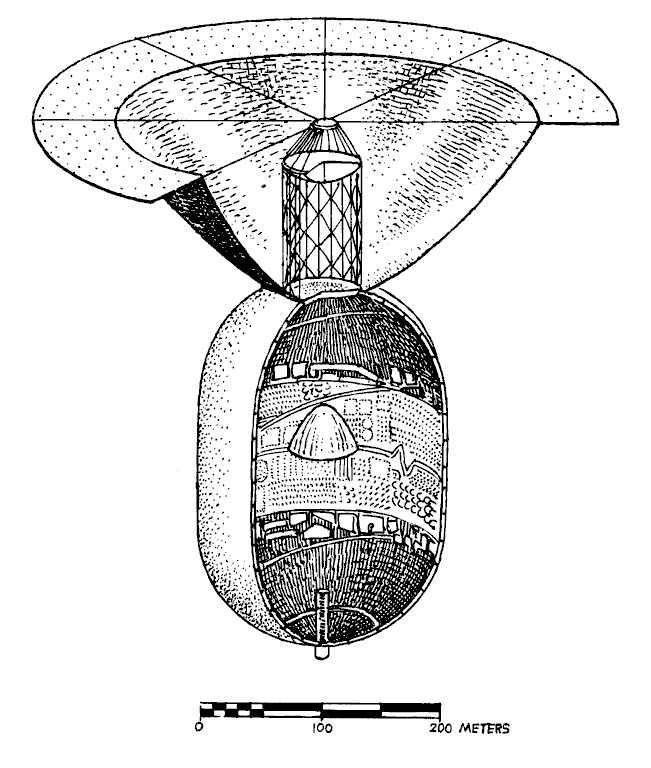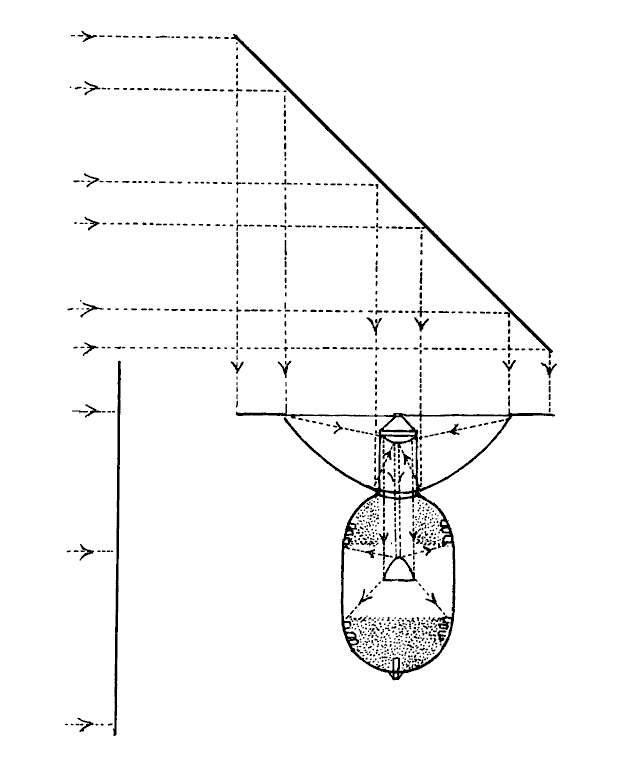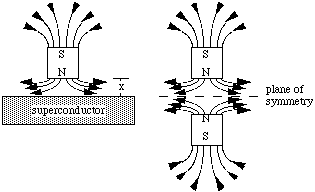New Mars Forums
You are not logged in.
- Topics: Active | Unanswered
Announcement
Pages: 1
#1 2014-11-18 07:25:56
- Tom Kalbfus
- Banned
- Registered: 2006-08-16
- Posts: 4,401
An Artificial "Planet"
An artificial planet is one step beyond terraforming an existing planet, basically you build you planet at the right distance from a star, as planets often come with inconvenient sizes, gravities and distances from their star.
The lowest tech "artificial planet" is not a sphere but a cylinder which rotates for gravity.
a = v^2/r.
a is acceleration 9.81 meters per second squared
v is the tangential velocity or the rotation of the cylinder
r is the radius of the cylinder which we'll set equal to the radius of the Earth 6,400,000 m.
v = sqrt(a*r) = sqrt(9.81 m/(s^2) * 6,400,000 m) = 7,923.64 meters per second.
To get rotation rate find the circumference of the cylinder and divide by tangential velocity.
2*pi*r = 2*pi*6,400,000m = 40,212,386 meters
divide by 7,923.64 meters per second to get 5075 seconds = 84.58 minutes
This number looks familiar because it is also the orbital velocity and period of an object orbiting at the surface of the Earth, or in low Earth orbit, because in that case centripetal acceleration is counteracting the acceleration due to gravity producing effective weightlessness.
To get a cylinder with the equivalent area of Earth, first find the area of Earth which is the formular for area of a sphere.
A=4*pi*R^2
A = 4*pi*6.4^2 Mm^2 = 514.72 square megameters
The area of a Cylinder is
A=2*pi*R*h minus the end caps
Solve for L
L=A/(2*pi*R)
L=(514.72 Mm^2)/(2*pi*6.4 Mm) = 12.8 Mm
The inside of an artificial Earth cylinder when unrolled may look like this:
What you got to consider is that we only live on the surface of our world, all that stuff under our feet is not appreciated, the only part we are concerned about is Earth's surface, so we only need the material to create that surface. Hollowing out the Earth is easier said than done. The Earth's mass is 5.976 septillion kilograms (5.976 x 10^24 kg)
Mass is related to volume, The volume of the Earth is 1.087 x 10^12 km^3 according to my book.
The volume of a sphere is given by the formula
V=(4/3)*Pi*r^3
r = 6,378
V=(4/3)*Pi*6378^3 = 1,086,781,292,543 km^3 by my calculator, which is 1.087 x 10^12 km.
Divide Earth's mass by its volume and you get 5,497,700,091,996 kg per cubic km.
Now to find the volume of material to make a hollow sphere in the shape of the Earth you subtract a lesser radius sphere from it. The point on Earth closest to it center is 6,353 km, so we'll carve out a hollow that is 5 km below that point, so I'll calculate the volume of a sphere that is 6,348 km in radius.
r = 6,348 km
V=(4/3)*Pi*6,348^3 = 1,071,517,734,950 km^3 by my calculator
we subtract the lesser volume from the greater one to get 15,263,557,593, which is
1.526 x 10^10 km^3 we'll multiply that by mass per cubic km to get 83,914,461,983,222,344,325,628 kg for this hollow Earth, or 8.391 x 10^22 kg.
Do you know how much mass this is? As I look in my astronomy book, I find that the body that comes closest to this figure is Jupiter's Moon Io, with a mass of 8.94 x 10^22 kg.
So if I wanted to create a hollow Earth, I'd take apart the Moon Io and have to manipulate 8.94 x 10^22 kg of rocky moon instead of hollowing out 5,890,883,150,009,960,544,460,200 kg or
5.891 x 10^24 kg, you would have to move 70.2 times as much material to hollow out the Earth as to make an empty Earth-sized sphere out of the material of Io, seems to me it would be cheaper and cost less energy to make a hollow Earth out of Io than to hollow out the actual Earth.
The acceleration due to gravity on the surface of this hollow Earth is by the way 0.13763845291331 meters per second squared or 0.01403 times the gravity at Earth's surface. Fortunately a cylinder of the same diameter as Earth and same length as that diameter and same thickness as the hollow sphere I described would have the same mass as that sphere due to it having the same surface area. Rotate this cylinder at 7.92 km/sec with a rotation of 84.58 minutes, and with the mass of Io, you could create a hollow cylinder with the same surface area as Earth with mountains, oceans and deep ocean trenches as deep as the Earth's, a wall 150 km high at each end of the cylinder would keep in the atmosphere. At Jupiter's distance from the Sun you'd need a mirror with 5 times the surface area of the cylinder floor to concentrate sunlight into the cylinder and another bullet shaped parabolic mirror to distribute that sunlight across the interior of the cylinder.
This is the mirror architecture for this hollow cylinder design:
light paths are shown in this diagram
the scale of an Earth-sized cylinder is much larger of course.
We don't need the end caps of course, in a cylinder 12,756 km by 12,756 km we just have the middle part of that cylinder shown, remove the end caps, replace them with 150 km walls and centrifugal force will prevent the atmosphere from spilling out the sides, the cylinder would otherwise be open to space.
Offline
Like button can go here
#2 2014-11-18 13:10:12
- qraal
- Member
- From: Brisbane, Australia
- Registered: 2008-01-02
- Posts: 65
Re: An Artificial "Planet"
Nice idea Tom. One fly in the ointment is that there's nothing strong enough in existence to make it, aside from stable nuclear matter. And we don't (yet) know how to make that. Another problem is that 150 km isn't tall enough to retain air. Needs to be higher or have a magnetically retained ionosphere to provide the counter pressure at such altitudes.
Offline
Like button can go here
#3 2014-11-18 19:31:23
- Tom Kalbfus
- Banned
- Registered: 2006-08-16
- Posts: 4,401
Re: An Artificial "Planet"
Nice idea Tom. One fly in the ointment is that there's nothing strong enough in existence to make it, aside from stable nuclear matter. And we don't (yet) know how to make that. Another problem is that 150 km isn't tall enough to retain air. Needs to be higher or have a magnetically retained ionosphere to provide the counter pressure at such altitudes.
I always thought that the official altitude that space begins was at 100 km, so I put the walls at 150 km for good measure. Another thing to consider that with a rotating cylinder of that size, altitude increase is toward the center, and the fictional centrifugal force decreases linearly as one moves toward the center, with real gravity, the pull decreases by the inverse square law of increasing distance from the center, that basically means that gravity is going to be greater 150 km above the surface of the cylinder that it would be 150 km above the surface of Earth.
There I a trick that can be employed with rotating cylinders of immense size, not all of the mass need be part of the rotating structure. You are familiar with the concept of magnetic levitation?
You see the magnet does not touch the surface of the superconductor, it can slide past the superconductor at 7.92 km per second without friction, but the surface of the superconductor does support the weight of the magnets and perhaps whatever is on top of the magnets if the magnetic field is strong enough. So imagine two cylinders one inside the other, the outside cylinder does not rotate, so does not have to support its own weight under centrifugal force, all it has to do is repel magnetic fields on the outer surface of the inner cylinder and squeeze with enough force to counter the outward centrifugal force of the inner cylinder, there are three other Galilean moons to build this outer cylinder out of if need be If the outer cylinder has sufficient tensile strength and is thick enough, then I can add its inward force to the inner cylinder without adding its weight under that centrifugal force, as it is not spinning with that inner cylinder. the outer cylinder can be made out of ice and rock, as that is what the three other Galilean satellites are made out of.
Last edited by Tom Kalbfus (2014-11-18 19:41:17)
Offline
Like button can go here
Pages: 1
